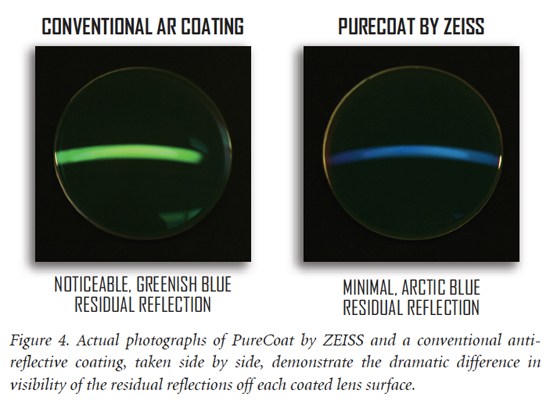Anti-reflective lenses usually have three or more thin layers of ceramic or metal oxide on each side of the lens. By varying the refractive index of each layer, reflections from one layer can be made to interact with reflections from the next layer. Through the process of destructive interference, the magnitude of these reflections is significantly decreased, while the amount of light transmitted by the lens is likewise increased. The use of multiple layers in the anti-reflective coating stack decreases the total reflectance of the lens (the total of the reflections of each surface) to less than 1 or 2 percent.
However, residual reflections still remain and are seen as a reflex color. The choice of reflex of color is also critical. The sensitivity of the human eye to the colors of the visible spectrum varies with each wavelength. The peak sensitivity of the eye lies within the green region of the spectrum at 555 nanometers, whereas the eye is considerably less sensitive to wavelengths at the blue and red ends.

Therefore, green colors appear brighter than colors at the other ends of the spectrum. The luminous reflectance of a lens represents the reflectance of the lens weighted by the sensitivity of the eye to each color. The maximum reflectance of standard anti-reflective coatings often lies near the peak sensitivity of the eye (Figure 2). The choice of this greenish reflex color limits the visual performance of many standard anti-reflective coatings. PureCoat by ZEISS, however, utilizes a broadband coating with maximum reflectance displaced away from the peak sensitivity of the eye toward the blue end of the visible spectrum. By controlling the luminous reflex color of the coating in this way, the total luminous reflectance of the lens is decreased to less than 1 percent, resulting in less noticeable residual reflections, while the luminous transmittance of the lens is increased to over 99 percent as well.
Shifting the color of the color reflex produces significantly less luminous reflectance and greater luminous transmittance. Due to the reduced color sensitivity of the eye for blue hues, this subtle blue reflex color is considerably less noticeable than the brighter green reflex colors of many conventional anti-reflective lenses (Figure 4).

|












